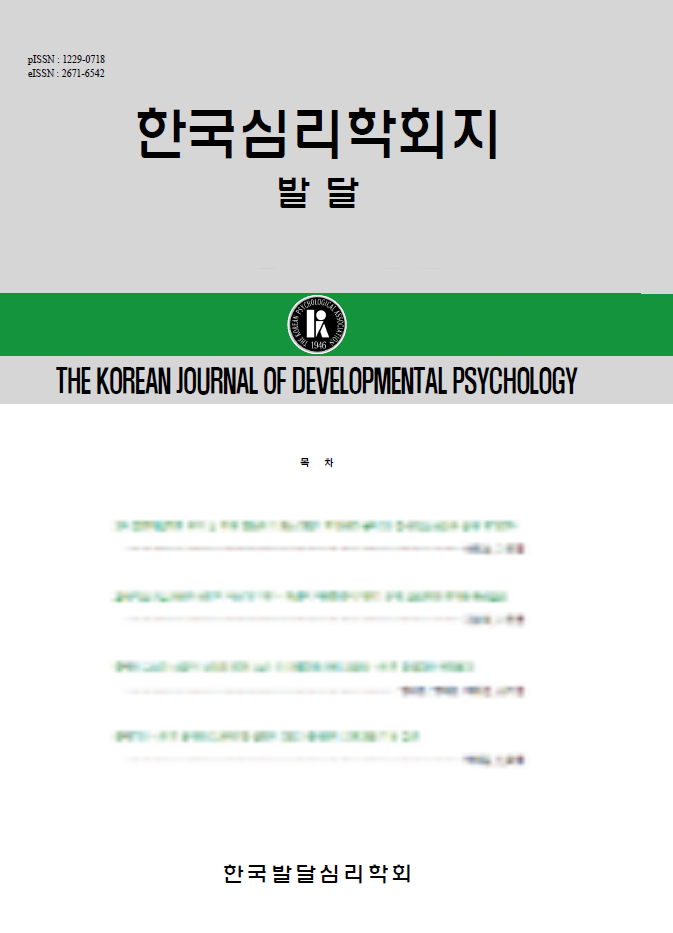open access
메뉴
open access
메뉴 ISSN : 1229-0718
ISSN : 1229-0718

The primary goal of this study was to examine the relations between adolescents' sympathy-distress emotion and prosocial behaviors on the adolescents’ cultural dispositions toward individualism and collectivism. The participants of the study were 699 adolescents(mean age= 16.7; 357 males, 312 females) from high schools in Seoul. Data were collected through self-report questionnaires. The major results of the study were as follow: First, adolescent's sex and distress emotion were significant variables in predicting adolescents' prosocial behaviors toward familiar persons, whereas cultural dispositions and distress emotion were significantly related to adolescents' prosocial behaviors toward strangers. A moderating effect of self-focused distress in the links between adolescents' cultural disposition and prosocial behavior was also found. Specifically, when adolescents' self-focused distress is low, Collectivism-oriented adolescents showed more prosocial behavior toward strangers than did Individualism-oriented adolescents. Second, Adolescents' emotion acted as a mediator between adolescents' cultural disposition and prosocial behaviors. That is, adolescents' cultural disposition directly and indirectly influenced (through experienced emotions) their prosocial behavior toward both familiar persons and strangers. This study underscores the importance of adolescents' sympathy-distress emotion and Individualism-collectivism cultural disposition in predicting adolescents' prosocial behaviors.
김기범(1996). 대인관계 속에서의 도덕성과 내집단-외집단 구별: 문화비교 분석 연구. 미간행석사학위논문, 중앙대학교.
김태운(2005). 중고생의 자아존중감과 문제행동및 친사회적 행동에 관한 연구. 연세대학교대학원 석사학위논문.
이옥경, 이순형(1996). 과제의 부담과 종류에 따른아동의 친사회적 도덕추론과 친사회적 행동.아동학회지, 17(1), 257-288.
조긍호, 김지연, 최경순(2009). 문화성향과 분노통제: 분노 수준과 공감의 매개효과를 중심으로.한국심리학회지: 사회 및 성격, 23(1), 69-90.
조긍호, 김지용(2001). 문화성향, 자의식 유형과공감수준. 한국사회 및 성격심리학회 2001년도 동계학술대회 논문집, 33-42.
한준수(2000). 개인특성과 친사회적 행동간의 관계 연구. 서울대학교 대학원 석사학위논문.
Asiye, K.(2002). Prosocial behavior within the family context and its correlates among Turkish early adolescents. Ph.D. Diss. Nebraska-Lincoln Univ.
Bal-Tal, D.(1982). Sequential development of helping behavior: A cognitive-learning approach. Developmental Review, 2, 101-124.
Baron, R., & Kenny, D.(1986). The moderator-mediator variable distinction in social psychological research: Conceptual, strategic, and atatistical considerations. Journal of Personality and Social Psychology, 51, 1173-1182.
Bar-Tal, D., Raviv, A., & Leiser, T.(1980). The development of altruistic behavior: Empirical evidence. Developmental Psychology, 16, 516-524.
Bischof-Kohler, D.(1991). The development of empathy in infants. In M. E. Lamb & H. Keller(Eds.), Infant development: Perspectives from German-speaking countries(pp. 245-273). Hillsdale, NJ: Erlbaum.
Davis, M.(1980). A multidimensional Approach to individual Difference in Empathy. JSAS Catalog of selected Document in Psychology, 10, 85.
Edwards, C., & 하영희(2005). 부모와 형제에 대한 초기청소년의 친사회적 행동에 영향을 미치는 부모애착, 사회경제적 지위 및 조망수용.한국심리학회지: 사회문제, 11(1) 43-57.
Eisenberg, N., Cumberland, A., Guthrie, I., Murphy, B., & Shepard, S.(2005). Age changes in prosocial responding and moral reasoning in adolesecence and early adulthood. Journal of Research in Adolescence, 15, 235-260.
Eisenberg, N., & Fabes, R.(1998). Prosocial development. In N. Eisenberg(ed.), Handbook of child psychology(5th ed., Vol. 3), NY: Wiley.
Eisenberg, N., Fabes, R., & Spinrad, T.(2006). Prosocial development. In W. Damon (ed): Handbook of child psychology, volume 3: Social, emotional, and personality development. 5th edition. New York: Wiley.
Eisenberg, N., & Lennon, R.(1983). Gender differences in empathy and related capacities. Psychological Bulletin, 94, 100-131.
Eisenberg, N., & Miller, P.(1987). The relation of empathy to prosocial and related behaviors. Psychological Bulletin, 10, 91-119.
Eisenberg, N., & Mussen, P.(1989). The roots of prosocial behavior in children. Cambridge, England: Cambridge University Press.
Friedlmeier, W., & Trommsdorff, G.(1999). Emotion regulation in early childhood: A cross-cultural comparison between German and Japanese toddlers. Journal of Cross-Cultural Psychology, 30, 684-711.
Gilligan(1982). In a Different Voice. Cambridge, Massachusettes, Harvard University Press.
Hastings, P., Rubin K., & Derose, L.(2005). Links among gender, inhibition, and parental socialization in the development of prosocial behavior. Merrill-palmer Quarterly, 51(4), 467-493.
Kagitcibasi, C.(2005). Autonomy and relatedness in cultural context: Implications for self and family. Journal of Cross-Cultural Psychology, 36(4), 403-422.
Killen, M., & Wainryb, C.(2000). Independence and interdependence in diverse cultural contexts. In S. Harkness & C. Raeff(Eds), Variability in the social construction of the child(pp.5-21). San Francisco: Jossey-Bass.
Kim, K., & Kim, U.(1997). Conflict, ingroup and outgroup distinction and mediation: Comparison of Korean and American students. In K. Leung, U. Kim, S. Yamaguchi, & Y. Kashima(Eds.), Progress in Asian social psychology(Vol. 1, pp. 247-259). Singapore:Wiley.
Miller, J.(1997). Cultural conceptions of duty: Implications for motivation and morality. In D. Munro, J. F. Schumaker, & S. Carr(Eds.), Motivation and culture(pp. 178-192). New York: Routledge.
Miller, P., Kozu, J., & Davis, A.(2001). Social influence, empathy, and prosocial behavior in cross-cultural perspective. In W.Wosinska, R.B.Cialdni, D.W.Barrett, & J. Reykowski(Eds.), The practice of social influence in multiple cultures. Applied social research series(pp. 63-77). Mahwah, NJ: Erlbaum.
Oyserman, D., Coon, H., & Kemmelmeier, M.(2002). Rethinking individualism and collectivism: Evaluation of theoretical assumptions and meta-analyses. Psychological Bulletin, 128, 3-72.
Persson, G.(2005). Young children's prosocial and aggressive behaviors and their experiences of being targeted for similar behaviors by peers. Social Development, 14, 206-228.
Radke-Yarrow, M., & Zahn-Waxler, C.(1984). Roots, motives, and patterns in children's prosocial behavior. In E. Staub, D. Bar-Tal, J. Karylowski, & J. Reykowski(Eds.), Development and maintenance of prosocial behavior: International perspectives on positive behavior(pp. 81-99). New York: Plenum Press.
Rothbaum, F., Pott, M., Azuma, H., Miyake, K.,& Weisz, J.(2000). The development of closerelationships in Japan and the UnitedStates: Paths of symbiotic harmony andgenerative tension. Child Development, 71,1121-1142.
Singelis, T., Triandis, H., Bhawuk, D., & Gelfand, M.(1995). Horizontal and vertical dimensions of individualism and collectivism: A theoretical and measurement refinement. Cross-Cultural Research, 29(3), 240-275.
Triandis, H.(1995). Individualism and collectivism. Boulder, CO: Westview.
Trommsdorff, G., Friedlmeier, W., & Mayer, B.(2007). Sympathy, distress, and prosocial behavior of preschool children in four cultures. International Journal of Behavioral Development, 31(3), 284-293.
Underwood, B., & Moore, B.(1982). Perspective-taking and altruism. Psychological Bulletin, 91, 143-173.
Vasta, R., Miller, S., & Ellis, S.(2004). Child Psychology(4th ed). New Jersey: John Wiley & Sons, Inc.
Whiting, B., & Whiting, J.(1975). Children of six cultures: A psychol-cultural analysis. Cambridge, MA: Harvard University Press.
Young, S., Fox, N., & Zahn-Waxler, C.(1999). The relations between temperament and empathy in 2-year-olds. Developmental Psychology, 35, 1189-1197.
